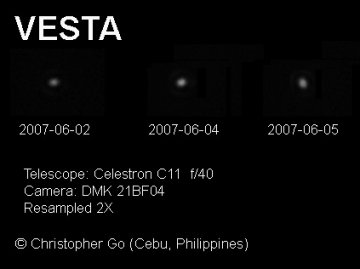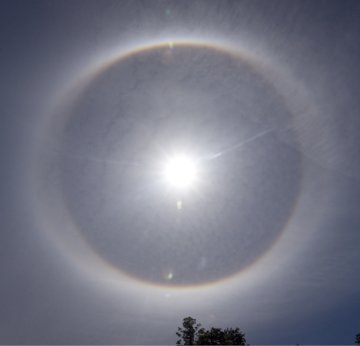 The space shuttle is docked to the ISS. Would you like a call when the pair fly over your backyard? Sign up for SpaceWeather PHONE. The space shuttle is docked to the ISS. Would you like a call when the pair fly over your backyard? Sign up for SpaceWeather PHONE. VOYAGE TO THE GIANT ASTEROIDS: This summer, NASA plans to launch a robotic probe to visit two stange and giant asteroids--one is covered with ice while the other may have been blasted by an ancient supernova. The tales these asteroids tell may reveal the true beginnings of our solar system: full story. VESTA: Speaking of giant asteroids... Christopher Go of the Philippines has managed to photograph asteroid Vesta tumbling through space using his 11-inch Celestron telescope: 
"It's been frustrating, trying to image such a small object," says Go. "As seen from Earth, Vesta is only 0.6 arcseconds wide. Perfect seeing was required." When NASA's Dawn spacecraft reaches Vesta in 2011, it will send back the first detailed images of this fascinating asteroid's surface. Photos taken by the Hubble Space Telescope hint that Vesta may be covered with ancient lava flows and magma seas much like our own Moon. These features are thought to be due, in part, to a nearby supernova billions of years ago: more. Want to see Vesta yourself? It is a speck, barely visible to the naked eye in the constellation Scorpius. Look south at midnight: sky map. SUN HALOS: This afternoon in the skies above Lake Pleasant, New York, a vivid luminous ring formed around the sun. "It was a beautiful sight; several of my neighbors rushed out to get photos," says Brian Bledsoe who joined in snapping this picture: 
Photo details: Canon 20D, 1/640s, f/18
This is actually two sun halos--a circular 22o halo on the inside and an oval circumscribed halo on the outside. Both are caused by pencil-shaped ice crystals in the high, thin clouds hovering today over Lake Pleasant. Because high clouds are always freezing, ice halos like these may appear in any season or latitude. Look for them!
2007 Noctilucent Photo Gallery
[Listen!] [Night-sky Cameras] | 
